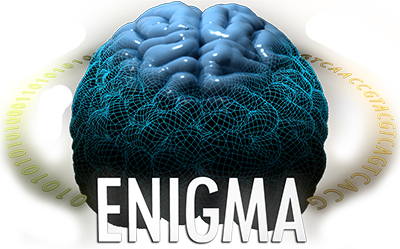All ENIGMA protocols are now linked on the ENIGMA GitHub page page. Please check here for the latest amendments and updates!
Anyone is welcome to use these protocols for their projects! If you use the protocols on this site for projects outside of ENIGMA, please include a reference to the ENIGMA main page (http://enigma.usc.edu/) so that your readers and reviewers know about it as well. If you are using the 'ENIGMA1' protocols, please cite Stein et al., Nature Genetics, 2012. If you are using the 'ENIGMA2' protocols, please cite Hibar et al., Nature, 2015. If you are using the 'ENIGMA3' protocols, please cite Grasby et al., Nature, 2020.
ENIGMA Cortical Quality Control Protocol 2.0 (April 2017)
The original ENIGMA Cortical QC protocol was updated in April 2017. While it does not create a departure from the former process and results, it will increase the ease of QC assessment. Thus, the QC 2.0 protocol may be used going forward but does not require any retroactive implementation.
- Step 1: Extract Cortical Measures from FreeSurfer
- Step 2: Steps for Quality Checking of Outputs
- Step 3: Get population summary statistics of the cortical traits and related histograms
-
The new guide includes updated quality control guidelines based on input from the ENIGMA Disease Working Groups and after quality checking thousands of subjects.
- ENIGMA Cortical QC Template
We developed this QC template to help streamline QC recordings and standardize the quality control information across sites.
ENIGMA3 - GWAS Meta Analysis of Cortical Thickness and Surface Area
For ENIGMA3, all participating ENIGMA sites will be extracting cortical measures using FreeSurfer software and the Image Processing Protocols outlined below.ENIGMA Subcortical Segmentation Protocols for Disease Working Groups
These protocols allow disease working groups to extract and visually inspect subcortical structures using FreeSurfer, R and a number of customized HTML scripts.- Subcortical volume extraction and visual inspection for disease working groups
ENIGMA-SHAPE
The success of subcortical volume analysis in disease and the remarkable GWAS discoveries lends itself to a more detailed look into subcortical structures. For more info, click here.ENIGMA2 - GWAS Meta Analysis of Subcortical Volumes
Below are the image processing protocols for GWAS meta-analysis of subcortical volumes, aka the ENIGMA2 project.ENIGMA1 - GWAS Meta Analysis of Hippocampal, Intracranial and Total Brain Volume
Below are the protocols from the ENIGMA pilot project (Stein et al., 2012, Nature Genetics):ENIGMA Longitudinal Cortical and Subcortical Segmentation Protocols from the ENIGMA-Plasticity Working Group
These protocols allow disease working groups to extract and visually inspect longitudinal cortical and subcortical structures using FreeSurfer and a number of customized HTML scripts.- Step 1: Longitudinal cortical and subcortical volume extraction
- Step 2: VIsual inspection of longitudinal cortical and subcortical volumes
- DOWNLOAD Longitudinal cortical and subcortical volume extraction and visual inspection scripts
ENIGMA Hippocampal Subfields Segmentation Protocols
These protocols allow for automated segmentation of the hippocampal subfields, alongside QC scripts and instructions. The current versions (updated Mar. 2022) are compatible with FreeSurfer algorithm versions 6.0 and 7.1.1.- Click here to access and download the ENIGMA-Hippocampal Subfields protocol, manual & QC guide.
Development and support: Philipp G. Sämann, Eugenio Iglesias, Neda Janashad, Laura van Velzen, Derrek Hibar, Theo van Erp, Christopher Whelan, Lianne SchmaalENIGMA-Sulci
This protocol allows you to segment, label, and visually inspect 123 cortical sulci/subject using FreeSurfer, BrainVISA, R and ImageMagick.- Google Drive containing the protocol & instructions for download here.
Contact: Fabrizio Pizzagalli (fpizzagalli@gmail.com)ENIGMA-VBM Tool
The ENIGMA Voxel Based Morphometry (VBM) tool is a fully automated pipeline that performs DARTEL VBM and a number of QC steps and sensitivity analyses. The tool packages up the group data for easy transfer to the coordinating site that performs the voxel-wise meta-analysis.- View and download the ENIGMA-VBM protocol & manual here.
Development: Matthew Kempton, King’s College LondonENIGMA Computational Anatomy Toolbox (CAT12)
These protocols use CAT12 to process voxel- and surface-based morphometry, but also enable region-based measures for volume and surface data. CAT12 includes various QC options and covers the entire analysis workflow, from cross-sectional or longitudinal data processing, to the statistical analysis, and visualization of results.- View and download the ENIGMA-CAT12 protocol here.
Development: Christian Gaser, Jena University HospitalENIGMA Cerebellum Volumetrics Pipeline
These protocols allow for automated segmentation of the cerebellum into 28 anatomical labels, and the option of cerebellum-optimised voxel-based morphometry, alongside QC scripts and instructions. Developed by the ENIGMA-Ataxia working group, in collaboration with Johns Hopkins University (ACAPULCO segmentation pipeline), Western University (SUIT VBM pipeline), and the ENIGMA-OCD working group (QC scripts).- Click here to access and download the ENIGMA-Cerebellum protocol, manual & QC guide.
Development and support: Rebecca Kerestes, Ian Harding, Shuo Han, Srinivas BalachanderENIGMA Toolbox
A Python/Matlab ecosystem for (i) accessing 100+ ENIGMA datasets, facilitating cross-disorder analysis, (ii) visualizing data on brain surfaces, and (iii) contextualizing findings at the microscale (postmortem cytoarchitecture and gene expression) and macroscale (structural and functional connectomes). The ENIGMA Toolbox equips scientists with tutorials to explore molecular, histological, and network correlates of noninvasive neuroimaging markers of brain disorders. Moreover, the ENIGMA Toolbox bridges the gap between standardized data processing protocols and analytic workflows and facilitates cross-consortia initiatives.- Documentation and openly available code: http://enigma-toolbox.readthedocs.io.
Development and support: Sara Larivière & Boris Bernhardt (MICA Lab - Montreal Neurological Institute).
- ENIGMA Cortical QC Template



